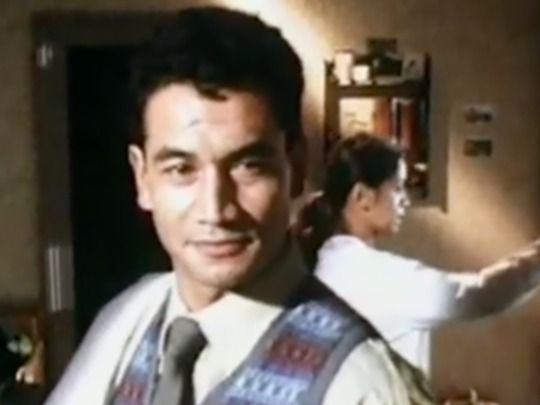
E Tipu e Rea
Television, 1989
Taking hold of the narrative
E tipu, e rea, mō ngā rā o tō ao; ko to ringaringa ki ngā rākau a te Pākehā hei oranga mō tō tinana;
ko tō ngākau ki ngā taonga o ō tïpuna hei tikitiki mō tō māhunga.
Ko tō wairua ki tō Atua, nāna nei ngā mea katoa.
Grow tender shoot for the days of your world. Turn your hand to the tools of the Pākehā for the well-being of your body.
Turn your heart to the treasures of your ancestors as a crown for your head.
Give your soul unto God the author of all things.
This 1989 series of Māori television dramas, E Tipu e Rea (‘Grow up tender young shoot') takes its title from a statement made by Sir Apirana Ngata (Ngāti Porou) to encourage Rangi Bennett (Te Arawa) — daughter of diplomat Charles Bennett — in her education. Ngata believed Māori advancement would benefit by reapplying learnings from Te Ao Pākehā (the Pākehā world) to Te Ao Māori (the Māori world), ideally resulting in a positive effect on both cultures.
His words were to influence generations of Māori. E Tipu e Rea presents a series of vignettes portraying that contact, and is an attempt to honour on-screen the spirit of Ngata's invocation. It screened in a late night slot on TV One, in November 1989.
The purpose of E Tipu e Rea was twofold: to showcase Māori-driven narratives, while creating a training ground for Māori creative talent in the industry. Aside from some notable exceptions, advocacy for Māori stories to remain under Māori control while creating a Māori industry hadn't fallen upon receptive funding ears.
It was largely due to the groundwork laid by Te Manu Aute, a collective of Māori in the film and television industry at the time, that E Tipu e Rea was eventually realised. Te Manu Aute members Barry Barclay and Merata Mita would direct the first Māori feature films: Ngati (1987) and Mauri (1988). Part of the collective's mission statement read: "Māori control means full control over the conceptualisation, management, execution and distribution of the project in question ... We note that it is very difficult to name a single media project that has been produced under these terms in the whole history of media in the country."
The collective engaged in strategising and intensive lobbying, and pulled in various industry representatives to advance the E Tipu e Rea vision. With the formation of a production house, Te Manuka Film Trust, E Tipu e Rea became a reality.
Now this was trailblazing stuff. Mana motuhake in action. Prior to television series like Koha and Tangata Whenua, Māori were largely an exotic source of cinematic candy. Despite this, Māori were very rarely in a position where they could determine Māori ownership and direction of stories. The description of the Māori presence in The Piano as "the blackground" aptly sums up the representation issue (although it was filmed after the series). All that was to change with E Tipu e Rea.
These are Māori characters determining their participation in the Pākeha world. Be it gambling (Te Moemoeā), schooling (Thunderbox, Variations on a Theme) or an unplanned pregnancy (Roimata), Māori are the protagonists. They are not passive, dumbed down, stereotypical self-representations.
The settings are varied. From post-war rural (Eel, Te Moemoeā), where horses and jalopies are the mode of transport, to a contemporary urban classroom where a teenage boy struggles to connect with the education system (Variations on a Theme, Thunderbox). Cross-generational relationships without a hint of impropriety are celebrated (Eel, Te Moemoeā, Thunderbox).
A couple of episodes hint at the impact of urbanisation upon Māori identity (Variations on a Theme, Roimata). Some are serious, others humorous, but all portray a diversity of Māori experience and interaction with the Pākehā world.
"First and foremost they are good stories," said series producer Larry Parr. "Their strength gives them universal appeal. When I was chosing the stories, the one criteria I used was 'does this appeal to me?'."
This is clean, economic storytelling at its best. There are no dramatic revelations or forced tension. Nor lectures, or condescending reminders of the good old halcyon days back at the pā. Pākehā are not one-dimensional villains. Instead they exist on the periphery. As expected. As they should. Why would their stories be at the centre of a Māori-driven narrative? As a Māori character says to a Pākehā character in Roimata, "just keep your Pākehā nose out of it".
One piece is completely in te reo Māori (Te Moemoeā), and can also be watched dubbed in English.
Careers were kickstarted through E Tipu e Rea. Writer Riwia Brown (who directed Roimata) would revisit themes of cultural alienation and urbanisation five years later, with her script for Once Were Warriors (1994). Warriors would be helmed by Thunderbox director Lee Tamahori; on Thunderbox he gained his first experience of directing drama outside of commercials.
Tamahori's future Warriors stars also featured: a 29-year old Temuera Morrison continued to develop his acting career with a role in Te Moemoeā, and Rena Owen made her screen debut after returning home from London theatre work, with roles in Roimata and a non-speaking part in Variations on a Theme. Young actors who began on the series included Blair Strang and Taungaroa Emile.
E Tipu e Rea was also a training ground for many Māori crew. Several would become key figures in the advent of the Māori Television Service, including series producer Larry Parr, who spent three years as Head of Programming at MTS.
Te Moemoeā scriptwriter Patricia Grace reflected at the time the series was shot: "if you look at advertisements on television and none of the people are of your culture, or appearance, or language, or background then you don't see yourself at all." This seres was a chance to help redress that balance.
Parr argued that E Tipu e Rea gave a lot of Māori people "their first experience in the industry. It's astounding the level of success many have had since making this series. They are working on commercials or television dramas and making a living out of it."
As the adage E Tipu e Rea shaped generations of Māori, so too did the series, by paving the way for future Māori television drama such as Ngā Puna (1995 and 1997), anthology series Mataku (2002) and Aroha (2001). Building Māori capacity in film and television would indeed fulfil the budding promise of Apirana Ngata's original statement.
- Maraea Rakuraku first dabbled in radio while studying at Canterbury University. She went on to do talkback at bilingual station Radio Waatea, then joined Radio New Zealand in 2006 to present and produce show Te Ahi Kaa.
